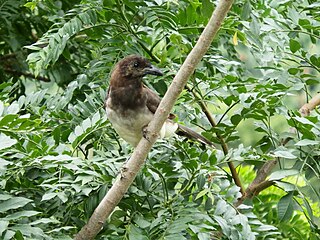
The brown jay is a large American jay which has the habitus of a magpie, but is slightly smaller and with a shorter tail, though the bill is larger.

Anacamptis is a genus from the orchid family (Orchidaceae); it is often abbreviated as Ant in horticulture. This genus was established by Louis Claude Richard in 1817; the type species is the pyramidal orchid and it nowadays contains about one-third of the species placed in the "wastebin genus" Orchis before this was split up at the end of the 20th century, among them many that are of hybrid origin. The genus' scientific name is derived from the Greek word anakamptein, meaning "to bend backwards".

Anacamptis morio, the green-winged orchid or green-veined orchid, is a flowering plant of the orchid family, Orchidaceae.
Yumi Kawai, better known by the stage name Yumi Morio, is a Japanese actress employed by the talent management firm Stardust Promotion.
Haydon Meadow known locally as Clifford Meadow is a 6.39 hectare biological Site of Special Scientific Interest in Wiltshire, notified in 1999.
Morio Asaka is a Japanese anime director.
A hepatoportoenterostomy or Kasai portoenterostomy is a surgical treatment performed on infants with Type IVb choledochal cyst and biliary atresia to allow for bile drainage. In these infants, the bile is not able to drain normally from the small bile ducts within the liver into the larger bile ducts that connect to the gall bladder and small intestine.

The chocolate wattled bat, species Chalinolobus morio, is a bat allied to the family Vespertilionidae. It is found only in Australia, including the island Tasmania, and widespread in southern regions. It is known to reside from sea level to at least 1,570 metres (5,150 ft) in Victoria.
The Cameroon soft-furred mouse or Cameroon praomys is a species of rodent in the family Muridae. It is found in Cameroon and Equatorial Guinea. Its natural habitat is subtropical or tropical moist montane forests. It is threatened by habitat loss.

The Sulawesi cicadabird is a species of bird in the family Campephagidae. It is endemic to Sulawesi in Indonesia. Its natural habitats are subtropical or tropical moist lowland forests and subtropical or tropical moist montane forests. The species is placed in the reinstated genus Edolisoma by some authors and the nominate subspecies E. morio morio was suggested to be part of the Edolisoma tenuirostre complex in a molecular phylogenetic study by Pedersen et al. (2018).

The Mount Cameroon forest shrew is a species of mammal in the family Soricidae endemic to Cameroon. Its natural habitat is subtropical or tropical moist montane forests.

Morio Higaonna is a prominent Okinawan karate practitioner who is the founder and former Chief Instructor of the International Okinawan Goju-ryu Karate-do Federation (IOGKF). He is a holder of the highest rank in Goju-ryu karate, 10th dan. Higaonna has written several books on Goju-ryu karate, including Traditional Karate-do: Okinawa Goju Ryu (1985) and The history of Karate: Okinawan Goju Ryu (2001). Martial arts scholar Donn Draeger (1922–1982) reportedly once described him as "the most dangerous man in Japan in a real fight."

Anacamptis morio subsp. longicornu, formerly classified as Anacamptis longicornu, is a subspecies of orchid. It is found in southern Europe and western North Africa.
Morio Shigematsu is a former Japanese long-distance runner who competed in marathons.
A number of karate techniques are used to deliver strikes to the human body. These techniques are delivered from a number of stances. The karateka uses a number of blocks to protect themselves against these strikes.
Thysanoprymna cepiana is a moth of the family Erebidae. It was described by Herbert Druce in 1893. It is found in Venezuela.
Thysanoprymna palmeri is a moth of the family Erebidae. It was described by Walter Rothschild in 1916. It is found in Colombia.
Thysanoprymna pyrrhopyga is a moth of the family Erebidae. It was described by Francis Walker in 1865. It is found in Brazil and Ecuador.
Thysanoprymna roseocincta is a moth of the family Erebidae. It was described by Adalbert Seitz in 1920. It is found in Colombia.
Thysanoprymna superba is a moth of the family Erebidae. It was described by William Schaus in 1889. It is found in Mexico, Costa Rica and Venezuela.










